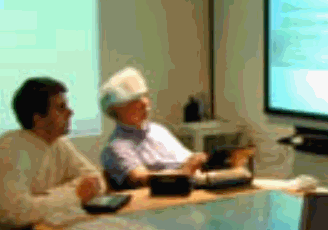Experiments in Interaction with Wall Displays
 Terry
Winograd, François
Guimbretière, and Brad Johanson, Stanford Computer
Science
Terry
Winograd, François
Guimbretière, and Brad Johanson, Stanford Computer
Science
winograd@cs.stanford.edu francois@cs.stanford.edu
Seminar on People, Computers,
and Design
Stanford University November 17, 2000
As display technologies continue to mature, we are approaching the day when large wall-mounted displays will be a common part of business, educational, and home environments. Today most uses of wall-displays are indirect. An audience views the large screen, while a presenter interacts with a workstation, laptop, or small device to control what appears. Early explorers of ubiquitous computing developed interactive wall displays, such as the Xerox Liveboard, They learned that to provide good interaction with these displays it was necessary to go beyond a simple translation of the standard keyboard/pointer interaction with workstations, and the physical mark-based interaction of non-computerized whiteboards or chalkboards.
In our Interactive Workspace, we are exploring new methods for multi-person interaction using multiple large wall-based displays. This talk describes some preliminary experiences as we begin to develop the interaction architecture. We will describe and show video clips of four of these explorations:
- FlowMenu: Combining command, text, and parameter entry with an integrated context menu.
- Geometer's Workbench: An active blackboard for geometrical exploration (with Sha Xinwei)
- BareHands: Implement-free interaction with a wall-mounted display (with Merrie Ringel)
- PointRight: A system for pointer/keyboard redirection among multiple displays and machines (with Brad Johanson, Greg Hutchins)
Terry Winograd is Professor of computer science at Stanford University, where he directs the program in Human-Computer Interaction. His current research interests include participation in the Digital Library Project and the Interactive Workspace Project. He has written or edited several books related to human-computer interaction, including Understanding Computers and Cognition (with Fernando Flores), Usability: Turning Technologies into Tools (with Paul Adler) and Bringing Design to Software.
François Guimbretière is a PhD student in Computer Science at Stanford, who has been a primary developer of the Interactive Mural, including the physical, computational, and interactional aspects.
View this talk on line at Stanford Online
Titles and abstracts for all years are available by year and by speaker.
For more information about HCI at Stanford see